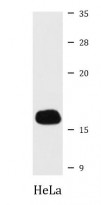ARG41613
anti-CDKN2A / p16INK4a antibody
anti-CDKN2A / p16INK4a antibody for ICC/IF,Western blot and Human
Chondrogenesis Study antibody
Overview
| Product Description | Rabbit Polyclonal antibody recognizes CDKN2A / p16INK4a |
|---|---|
| Tested Reactivity | Hu |
| Tested Application | ICC/IF, WB |
| Host | Rabbit |
| Clonality | Polyclonal |
| Isotype | IgG |
| Target Name | CDKN2A / p16INK4a |
| Antigen Species | Human |
| Immunogen | Synthetic peptide of Human CDKN2A / p16INK4a. |
| Conjugation | Un-conjugated |
| Alternate Names | Alternative reading frame; CDK4I; P19ARF; P16INK4A; CDKN2; Tumor suppressor ARF; MTS-1; P14; P16; P19; Cyclin-dependent kinase inhibitor 2A; P16INK4; MLM; p14ARF; MTS1; INK4; TP16; P16-INK4A; CMM2; ARF; P14ARF; INK4A |
Application Instructions
| Application Suggestion |
|
||||||
|---|---|---|---|---|---|---|---|
| Application Note | * The dilutions indicate recommended starting dilutions and the optimal dilutions or concentrations should be determined by the scientist. | ||||||
| Observed Size | ~ 16 kDa |
Properties
| Form | Liquid |
|---|---|
| Purification | Affinity purified. |
| Buffer | PBS (pH 7.3), 0.02% Sodium azide and 50% Glycerol. |
| Preservative | 0.02% Sodium azide |
| Stabilizer | 50% Glycerol |
| Storage Instruction | For continuous use, store undiluted antibody at 2-8°C for up to a week. For long-term storage, aliquot and store at -20°C. Storage in frost free freezers is not recommended. Avoid repeated freeze/thaw cycles. Suggest spin the vial prior to opening. The antibody solution should be gently mixed before use. |
| Note | For laboratory research only, not for drug, diagnostic or other use. |
Bioinformation
| Database Links |
Swiss-port # P42771 Human Cyclin-dependent kinase inhibitor 2A |
|---|---|
| Gene Symbol | CDKN2A |
| Gene Full Name | cyclin-dependent kinase inhibitor 2A |
| Background | This gene generates several transcript variants which differ in their first exons. At least three alternatively spliced variants encoding distinct proteins have been reported, two of which encode structurally related isoforms known to function as inhibitors of CDK4 kinase. The remaining transcript includes an alternate first exon located 20 Kb upstream of the remainder of the gene; this transcript contains an alternate open reading frame (ARF) that specifies a protein which is structurally unrelated to the products of the other variants. This ARF product functions as a stabilizer of the tumor suppressor protein p53 as it can interact with, and sequester, the E3 ubiquitin-protein ligase MDM2, a protein responsible for the degradation of p53. In spite of the structural and functional differences, the CDK inhibitor isoforms and the ARF product encoded by this gene, through the regulatory roles of CDK4 and p53 in cell cycle G1 progression, share a common functionality in cell cycle G1 control. This gene is frequently mutated or deleted in a wide variety of tumors, and is known to be an important tumor suppressor gene. [provided by RefSeq, Sep 2012] |
| Function | Capable of inducing cell cycle arrest in G1 and G2 phases. Acts as a tumor suppressor. Binds to MDM2 and blocks its nucleocytoplasmic shuttling by sequestering it in the nucleolus. This inhibits the oncogenic action of MDM2 by blocking MDM2-induced degradation of p53 and enhancing p53-dependent transactivation and apoptosis. Also induces G2 arrest and apoptosis in a p53-independent manner by preventing the activation of cyclin B1/CDC2 complexes. Binds to BCL6 and down-regulates BCL6-induced transcriptional repression. Binds to E2F1 and MYC and blocks their transcriptional activator activity but has no effect on MYC transcriptional repression. Binds to TOP1/TOPOI and stimulates its activity. This complex binds to rRNA gene promoters and may play a role in rRNA transcription and/or maturation. Interacts with NPM1/B23 and promotes its polyubiquitination and degradation, thus inhibiting rRNA processing. Interacts with COMMD1 and promotes its 'Lys63'-linked polyubiquitination. Interacts with UBE2I/UBC9 and enhances sumoylation of a number of its binding partners including MDM2 and E2F1. Binds to HUWE1 and represses its ubiquitin ligase activity. May play a role in controlling cell proliferation and apoptosis during mammary gland development. Isoform smARF may be involved in regulation of autophagy and caspase-independent cell death; the short-lived mitochondrial isoform is stabilized by C1QBP. [UniProt] |
| Cellular Localization | Cytoplasm. Nucleus. [UniProt] |
| Highlight | Related products: CDKN2A antibodies; CDKN2A Duos / Panels; Anti-Rabbit IgG secondary antibodies; Related news: Senescence Marker Antibody Panel is launched |
| Research Area | Chondrogenesis Study antibody |
| Calculated MW | 14 kDa |
| PTM | Ubiquitinated in normal cells by TRIP12 via the ubiquitin fusion degradation (UFD) pathway, a process that mediates ubiquitination at the N-terminus, regardeless of the absence of lysine residues. Ubiquitination leads to its proteasomal degradation. In cancer cells, however, TRIP12 is located in a different cell compartment, preventing ubiquitination and degradation. [UniProt] |
Images (2) Click the Picture to Zoom In
-
ARG41613 anti-CDKN2A / p16INK4a antibody ICC/IF image
Immunofluorescence: A549 cells stained with ARG41613 anti-CDKN2A / p16INK4a antibody.
-
ARG41613 anti-CDKN2A / p16INK4a antibody WB image
Western blot: 25 µg of HeLa cell lysate stained with ARG41613 anti-CDKN2A / p16INK4a antibody at 1:1000 dilution.







